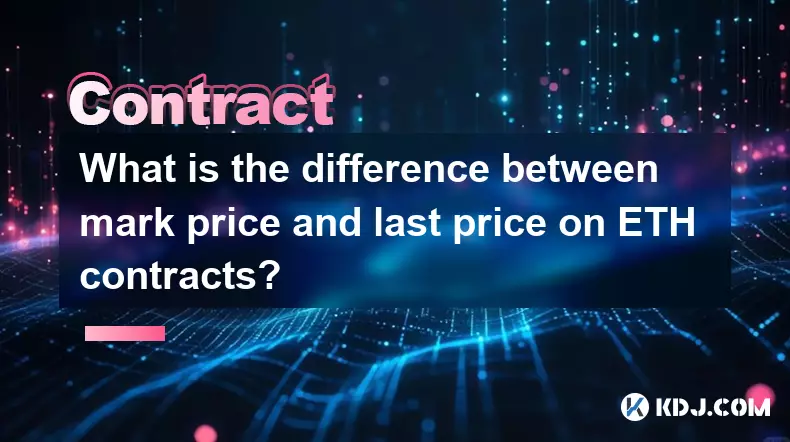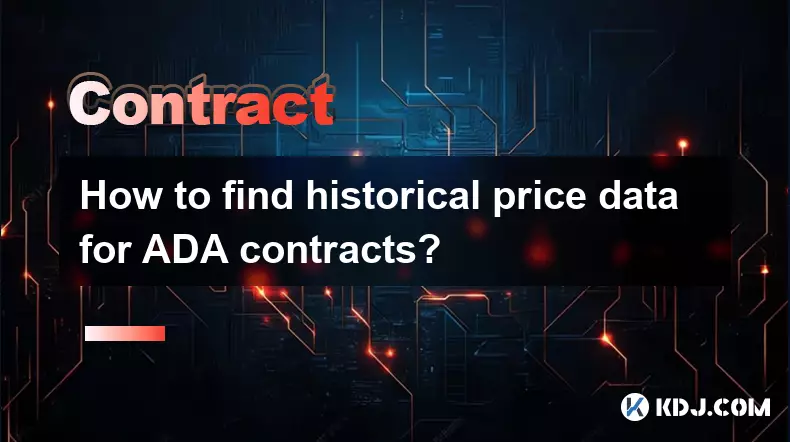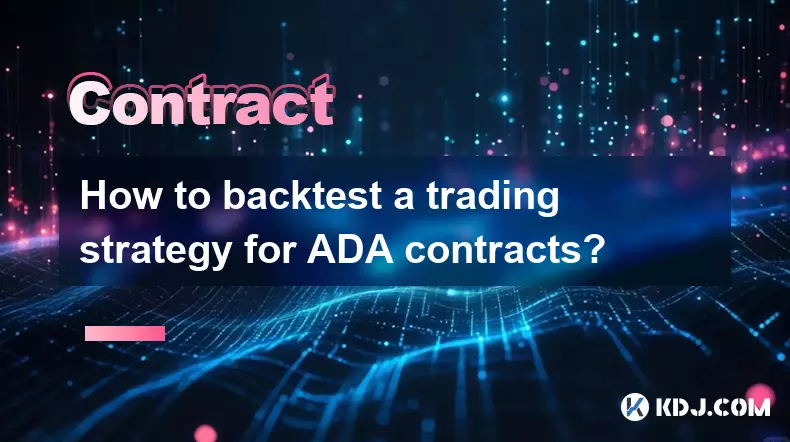-
 bitcoin
bitcoin $108309.944805 USD
-1.81% -
 ethereum
ethereum $3861.653445 USD
-2.57% -
 tether
tether $1.000476 USD
0.02% -
 bnb
bnb $1064.809647 USD
-3.07% -
 xrp
xrp $2.422923 USD
-2.29% -
 solana
solana $186.552328 USD
-0.93% -
 usd-coin
usd-coin $0.999917 USD
0.00% -
 tron
tron $0.322438 USD
-0.01% -
 dogecoin
dogecoin $0.194315 USD
-2.57% -
 cardano
cardano $0.642133 USD
-3.06% -
 chainlink
chainlink $17.657259 USD
-6.17% -
 hyperliquid
hyperliquid $35.120261 USD
-7.45% -
 ethena-usde
ethena-usde $0.999614 USD
0.03% -
 stellar
stellar $0.312748 USD
-3.27% -
 bitcoin-cash
bitcoin-cash $480.377391 USD
0.23%
What is the difference between mark price and last price on ETH contracts?
Scientists have discovered a new exoplanet located in the habitable zone of its star, raising hopes for finding extraterrestrial life.
Oct 19, 2025 at 08:00 am

Understanding Mark Price in ETH Derivatives
1. The mark price is a calculated value used to prevent manipulation and ensure fair settlement on ETH perpetual contracts. It reflects the true market value by incorporating data from external price oracles and funding rates. This mechanism discourages traders from artificially inflating or deflating the price near liquidation points.
2. Exchanges pull the underlying spot price of Ethereum from multiple reputable sources, such as major centralized exchanges and decentralized price feeds. These values are averaged and smoothed over time to form the base for the mark price, making it resistant to sudden spikes or dips caused by low-liquidity trades.
3. Funding rate adjustments are factored into the mark price to align the contract's value with the spot market. When the perpetual contract trades significantly above spot, longs pay shorts through positive funding, nudging the mark price closer to equilibrium. The reverse occurs when shorts dominate.
The mark price plays a critical role in determining whether a position gets liquidated, protecting users from flash crashes or pump-based attacks.The Nature of Last Price in Trading Activity
1. The last price refers to the most recent transaction executed on the order book for an ETH futures or perpetual contract. It represents real-time trading activity and changes with every new trade, regardless of size or liquidity impact.
2. Unlike the mark price, the last price can be influenced by large market orders that temporarily move the market. A single whale buying aggressively can spike the last price without reflecting broader market consensus, especially on lower-volume platforms.
3. Traders often watch the last price for entry and exit signals because it shows actual execution levels. However, relying solely on this metric may lead to misjudging fair value, particularly during volatile periods or thin markets.
Because the last price reflects executable trades, it serves as a direct indicator of short-term momentum but lacks stability compared to the mark price.Divergence Between Mark and Last Prices
1. Temporary discrepancies between mark and last prices are common, especially during high volatility or rapid news events. For example, if ETH drops 5% in seconds due to macroeconomic news, the last price will plunge immediately while the mark price adjusts more gradually.
2. Arbitrageurs monitor these gaps closely. If the last price trades significantly above the mark, they may short the contract and hedge in spot markets, profiting from convergence. This behavior helps bring both prices back into alignment.
3. Liquidation engines use the mark price, not the last price, to determine margin calls. A trader might see their position liquidated even if the last price briefly recovers, because the system relies on the more stable and secure mark price.
4. On certain exchanges, insurance funds are designed around mark price calculations to avoid insolvency during cascading liquidations triggered by manipulated last prices.
Risk Management Implications for Traders
1. Positions with high leverage are more sensitive to differences between mark and last prices. A sharp drop in last price combined with a lagging mark price adjustment can result in unexpected liquidations despite apparent recovery.
2. Stop-loss orders based on last price may execute at unfavorable levels during flash crashes, whereas using mark price-based triggers offers more protection against spoofing and wash trades.
3. Long-term holders of ETH contracts should focus on funding rate trends and mark price movement rather than chasing last price fluctuations, which often reflect noise rather than directional strength.
Effective risk control requires understanding how each price metric functions within the exchange’s ecosystem, particularly under stress conditions.Frequently Asked Questions
Why do exchanges use mark price instead of last price for liquidations?Using the mark price prevents bad actors from manipulating the last traded price to trigger mass liquidations. By anchoring liquidations to a more reliable and externally verified value, exchanges enhance platform integrity and user trust.
Can the mark price be wrong?While highly resilient, the mark price depends on oracle accuracy. If primary price sources fail or report incorrect data, the mark price may deviate. Most platforms implement fallback mechanisms and circuit breakers to mitigate such risks.
Does the last price affect profit and loss calculations?Yes, realized PnL upon closing a position is based on the last price at execution. However, unrealized PnL displayed in portfolios often uses the mark price to reflect a conservative estimate of current value.
How frequently is the mark price updated?Mark price updates occur continuously, typically every few seconds, depending on the exchange. Updates are synchronized with oracle heartbeat intervals and funding rate checkpoints to maintain consistency across all active contracts.
Disclaimer:info@kdj.com
The information provided is not trading advice. kdj.com does not assume any responsibility for any investments made based on the information provided in this article. Cryptocurrencies are highly volatile and it is highly recommended that you invest with caution after thorough research!
If you believe that the content used on this website infringes your copyright, please contact us immediately (info@kdj.com) and we will delete it promptly.
- BlockDAG's Top 30 Ambition: AMA Buzz and Genesis Day Countdown
- 2025-10-23 01:35:12
- BlockDAG's Presale Dominance: A Crypto Ranking Game Changer?
- 2025-10-23 01:15:12
- Blazpay Presale Heats Up as Polkadot Eyes Recovery: A Crypto Investor's Dilemma
- 2025-10-23 00:55:11
- Meme Coins, Crypto Millionaires, and Shiba Inu: What's Next?
- 2025-10-23 01:15:12
- FalconX & 21Shares: A Crypto Power Couple Emerges Through Acquisition
- 2025-10-23 00:55:11
- DePIN & Crypto Projects in 2025: A Glimpse into the Future
- 2025-10-23 00:30:13
Related knowledge

What are quarterly vs. perpetual ADA contracts?
Oct 19,2025 at 08:55am
Understanding Quarterly and Perpetual ADA ContractsDerivatives trading in the cryptocurrency space has expanded rapidly, offering traders various inst...

How to find historical price data for ADA contracts?
Oct 18,2025 at 10:18pm
Understanding ADA and Its Market Data Availability1. Cardano’s native cryptocurrency, ADA, operates on a decentralized blockchain that supports smart ...

How to backtest a trading strategy for ADA contracts?
Oct 21,2025 at 02:37pm
Understanding the Basics of Backtesting ADA Contracts1. Backtesting a trading strategy for Cardano (ADA) contracts involves applying historical price ...

How to read the order book for ADA contracts effectively?
Oct 22,2025 at 06:37am
Understanding the Structure of the ADA Order Book1. The order book for ADA contracts displays a real-time list of buy and sell orders organized by pri...

How to hedge my spot Cardano portfolio with ADA contracts?
Oct 18,2025 at 05:36am
Hedging Your ADA Spot Holdings Using Derivatives1. Identify a reliable exchange that offers ADA futures or perpetual contracts. Exchanges like Binance...

How are the trading fees for ADA contracts calculated on Binance?
Oct 19,2025 at 03:18pm
Understanding ADA Futures Fee Structure on Binance1. Trading fees for ADA perpetual contracts on Binance are determined using a tiered system based on...

What are quarterly vs. perpetual ADA contracts?
Oct 19,2025 at 08:55am
Understanding Quarterly and Perpetual ADA ContractsDerivatives trading in the cryptocurrency space has expanded rapidly, offering traders various inst...

How to find historical price data for ADA contracts?
Oct 18,2025 at 10:18pm
Understanding ADA and Its Market Data Availability1. Cardano’s native cryptocurrency, ADA, operates on a decentralized blockchain that supports smart ...

How to backtest a trading strategy for ADA contracts?
Oct 21,2025 at 02:37pm
Understanding the Basics of Backtesting ADA Contracts1. Backtesting a trading strategy for Cardano (ADA) contracts involves applying historical price ...

How to read the order book for ADA contracts effectively?
Oct 22,2025 at 06:37am
Understanding the Structure of the ADA Order Book1. The order book for ADA contracts displays a real-time list of buy and sell orders organized by pri...

How to hedge my spot Cardano portfolio with ADA contracts?
Oct 18,2025 at 05:36am
Hedging Your ADA Spot Holdings Using Derivatives1. Identify a reliable exchange that offers ADA futures or perpetual contracts. Exchanges like Binance...

How are the trading fees for ADA contracts calculated on Binance?
Oct 19,2025 at 03:18pm
Understanding ADA Futures Fee Structure on Binance1. Trading fees for ADA perpetual contracts on Binance are determined using a tiered system based on...
See all articles










































































